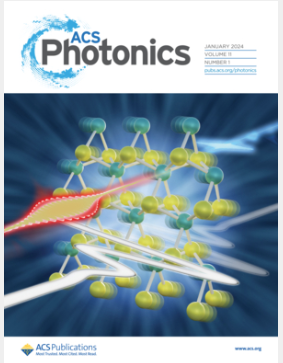Parallel Wideband Chaos Generation System for Advancing High-Throughput Information Processing Based on an Array of Four Distributed Feedback Lasers
IF 6.5
1区 物理与天体物理
Q1 MATERIALS SCIENCE, MULTIDISCIPLINARY
引用次数: 0
Abstract
Optical chaos, especially in the form of parallel temporal/spatial chaos, presents a highly efficient approach for high-throughput information processing in diverse applications such as optical communication and reinforcement learning. However, despite these advancements, current approaches mainly focus on achieving enhanced single-channel performance or compromised multichannel realization (e.g., sacrificing the bandwidth, individual control, or system complexity). In this study, an integrated laser array with intensity-modulated optical injection is exclusively fabricated and employed to produce parallel optical chaos exhibiting independent and wideband characteristics. We demonstrate in a proof-of-concept experiment that allows for feasibly generating four parallel chaotic signals with a bandwidth exceeding 30 GHz, which is only limited by the detection devices. Benefiting from the high-frequency oscillations and faster dynamics of the on-chip laser array, the physical (physical-based pseudo) random bit generation rate can reach up to 1.6 Tb/s (15.04 Tb/s) by leveraging two postprocessing methods. We further expand the superiority of our proposed approach by demonstrating parallel benchmark decision-making, where we testify both experimentally and numerically that our fabricated laser array system outperforms the existing conventional approaches. This work explores novel avenues for high-throughput information processing by deploying chip-scale parallel chaotic systems.

基于四个分布式反馈激光器阵列的并行宽带混沌发生系统,用于推进高吞吐量信息处理
光学混沌,尤其是并行的时间/空间混沌形式,为光通信和强化学习等各种应用中的高通量信息处理提供了一种高效方法。然而,尽管取得了这些进步,目前的方法主要集中在实现增强的单通道性能或折衷的多通道实现(例如,牺牲带宽、单个控制或系统复杂性)。在本研究中,我们专门制作了具有强度调制光注入功能的集成激光器阵列,并利用该阵列产生了具有独立宽带特性的并行光混沌。我们在概念验证实验中演示了产生四个并行混沌信号的可行性,其带宽超过 30 GHz,仅受检测设备的限制。得益于片上激光阵列的高频振荡和更快的动态,通过利用两种后处理方法,物理(基于物理的伪)随机比特生成率可高达 1.6 Tb/s(15.04 Tb/s)。我们通过演示并行基准决策,进一步扩大了我们提出的方法的优越性,我们在实验和数值上证明,我们制造的激光阵列系统优于现有的传统方法。这项工作通过部署芯片级并行混沌系统,探索了高通量信息处理的新途径。
本文章由计算机程序翻译,如有差异,请以英文原文为准。
求助全文
约1分钟内获得全文
求助全文
来源期刊

ACS Photonics
NANOSCIENCE & NANOTECHNOLOGY-MATERIALS SCIENCE, MULTIDISCIPLINARY
CiteScore
11.90
自引率
5.70%
发文量
438
审稿时长
2.3 months
期刊介绍:
Published as soon as accepted and summarized in monthly issues, ACS Photonics will publish Research Articles, Letters, Perspectives, and Reviews, to encompass the full scope of published research in this field.
 求助内容:
求助内容: 应助结果提醒方式:
应助结果提醒方式:


